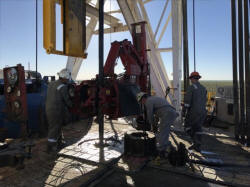|
Oil prices fall as OPEC
output, U.S. crude stockpiles rise
 Send a link to a friend
Send a link to a friend
 [June 14, 2017]
By Christopher Johnson [June 14, 2017]
By Christopher Johnson
LONDON
(Reuters) - Oil prices fell on Wednesday after industry data showed a
build in U.S. crude stocks and OPEC reported a rise in its production
despite a pledge to cut output.
Brent crude oil was down 36 cents a barrel at $48.36 by 0941 GMT. U.S.
crude was 45 cents lower at $46.01.
Crude prices have fallen more than 10 percent since late May, pulled
down by heavy global oversupply that has persisted despite a move led by
the Organization of the Petroleum Exporting Countries to curb
production.
OPEC and other exporters such as Russia have agreed to keep production
almost 1.8 million barrels per day (bpd) below the levels pumped at the
end of last year and not to increase output until the end of the first
quarter of 2018.
But adherence to the cuts is under scrutiny and the producer group said
this week that its output rose by 336,000 bpd in May to 32.14 million
bpd.
Oil stocks are near record highs in some parts of the world, and
producers that are not part of the OPEC deal are increasing output.

The International Energy Agency on Wednesday said it expected growth in
non-OPEC supply to be higher next year than growth in overall global
demand. [IEA/M]
"For total non-OPEC production, we expect production to grow by 700,000
bpd this year, but our first outlook for 2018 makes sobering reading for
those producers looking to restrain supply," the IEA said in its monthly
oil market report.
Shale supply has pushed U.S. crude production up by about 10 percent
over the last year to 9.3 million bpd - not far below the output of top
exporter Saudi Arabia. <C-OUT-T-EIA>
"The outlook for oil hinges on the effectiveness of the OPEC cuts
relative to the supply increases from U.S. shale," said William
O'Loughlin, analyst at Australia's Rivkin Securities.
[to top of second column] |

Workers clamp together pieces of pipe while drilling an oil well
near Fort Stockton, Texas, U.S., May 4, 2017. REUTERS/Ernest
Scheyder

Data
from the American Petroleum Institute showed on Tuesday that U.S. crude stocks
rose by 2.8 million barrels in the week to June 9 to 511.4 million, compared
with expectations for a decrease of 2.7 million barrels. [API/S]
With supplies plentiful, strong demand is needed to support the market, but
there are signs of a slowdown.
Global energy demand grew by 1 percent in 2016, a rate similar to the previous
two years but well below the 10-year average of 1.8 percent, BP <BP.L> said in
its benchmark Statistical Review of World Energy on Tuesday.
Economic expansion in China, a key component of world oil demand growth for many
years, is now slowing.
"Chinese demand is slow ... so we have a build-up of crude in Asia where demand
seems to have slowed for now," said Oystein Berentsen, managing director of oil
trading company Strong Petroleum.
(Additional reporting by Henning Gloystein in SINGAPORE; Editing by Dale Hudson)
[© 2017 Thomson Reuters. All rights
reserved.] Copyright 2017 Reuters. All rights reserved. This material may not be published,
broadcast, rewritten or redistributed.
 |